Analysis of Treated Wastewater Return in Murray Darling Basin Plan
VerifiedAdded on 2021/04/19
|36
|8294
|39
Report
AI Summary
This report delves into the complexities of the Murray Darling Basin Plan, addressing the challenges of water scarcity, environmental impacts, and the role of treated wastewater return. It provides a comprehensive overview of the basin's geographical, climatic, and ecological conditions, highlighting the historical changes and the impact of human activities, including dam construction and agricultural practices. The report examines the problems statement, risk assessment strategies, and the legislative framework governing the basin. It emphasizes the importance of knowledge management in addressing the basin's issues and presents various strategies for improvement. The report analyzes the impact of climate change, groundwater usage, and water management plans. It also offers several recommendations for enhancing knowledge management to resolve the challenges within the Murray Darling Basin, making it a valuable resource for understanding the environmental and economic dynamics of this critical region.
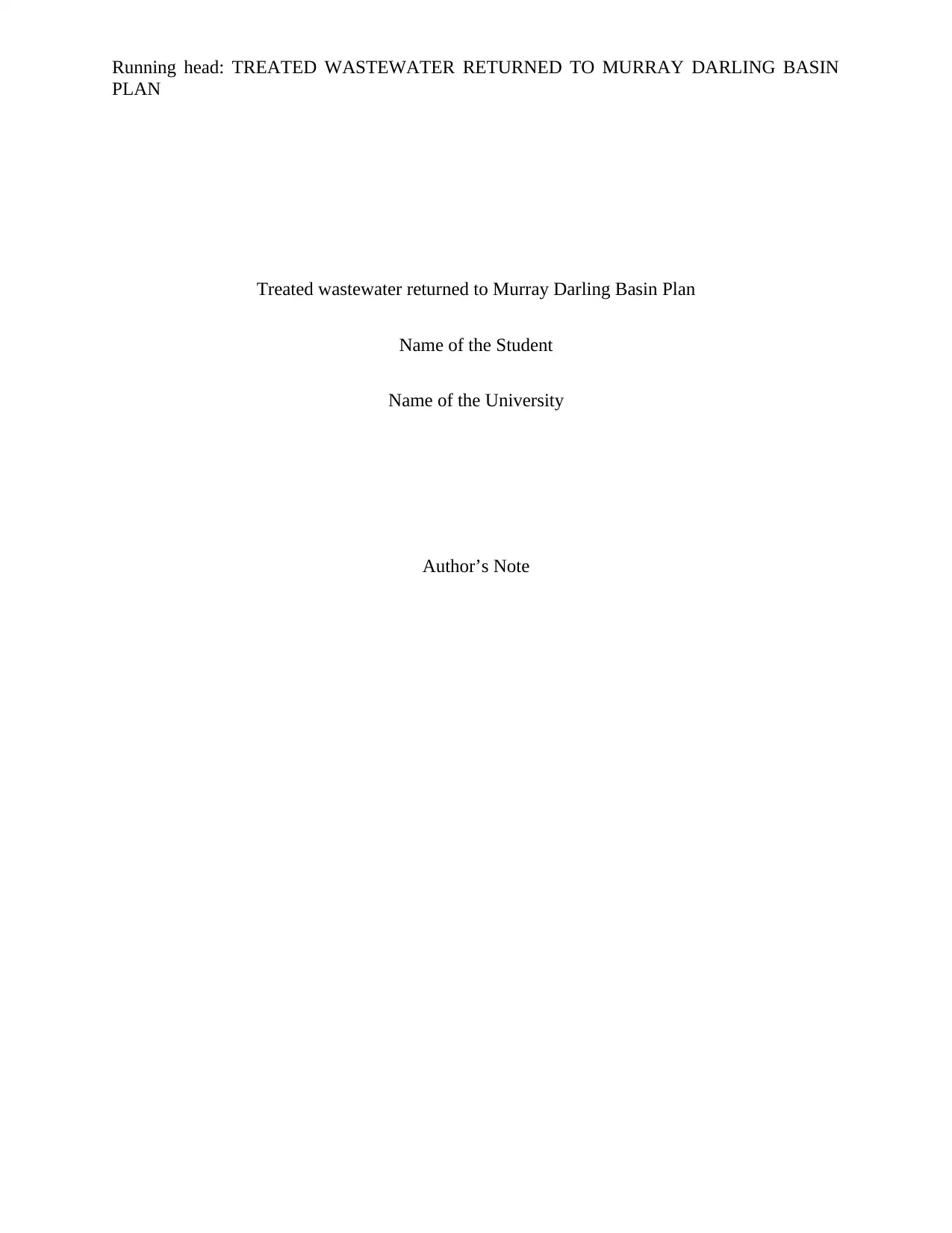
Running head: TREATED WASTEWATER RETURNED TO MURRAY DARLING BASIN
PLAN
Treated wastewater returned to Murray Darling Basin Plan
Name of the Student
Name of the University
Author’s Note
PLAN
Treated wastewater returned to Murray Darling Basin Plan
Name of the Student
Name of the University
Author’s Note
Paraphrase This Document
Need a fresh take? Get an instant paraphrase of this document with our AI Paraphraser
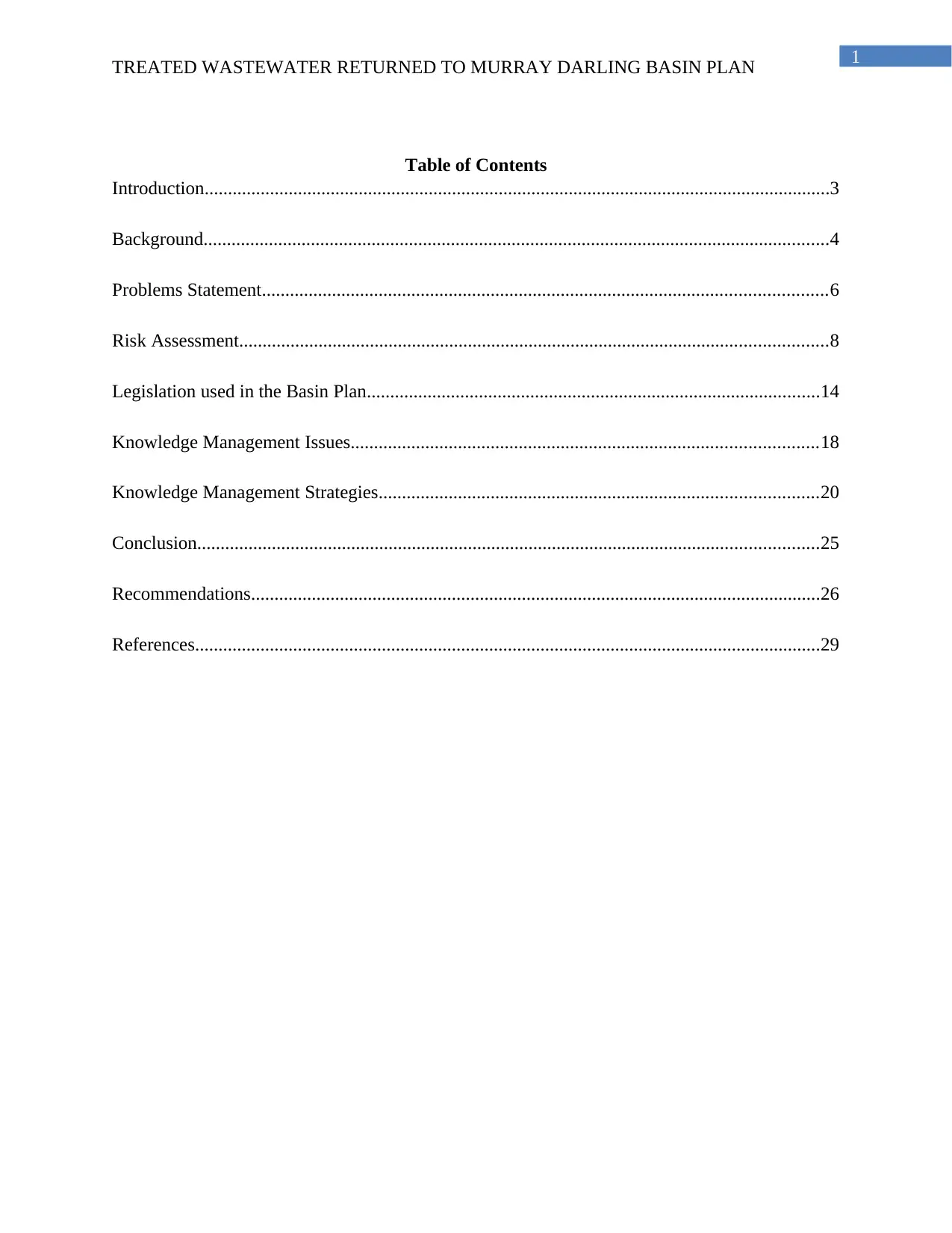
1
TREATED WASTEWATER RETURNED TO MURRAY DARLING BASIN PLAN
Table of Contents
Introduction......................................................................................................................................3
Background......................................................................................................................................4
Problems Statement.........................................................................................................................6
Risk Assessment..............................................................................................................................8
Legislation used in the Basin Plan.................................................................................................14
Knowledge Management Issues....................................................................................................18
Knowledge Management Strategies..............................................................................................20
Conclusion.....................................................................................................................................25
Recommendations..........................................................................................................................26
References......................................................................................................................................29
TREATED WASTEWATER RETURNED TO MURRAY DARLING BASIN PLAN
Table of Contents
Introduction......................................................................................................................................3
Background......................................................................................................................................4
Problems Statement.........................................................................................................................6
Risk Assessment..............................................................................................................................8
Legislation used in the Basin Plan.................................................................................................14
Knowledge Management Issues....................................................................................................18
Knowledge Management Strategies..............................................................................................20
Conclusion.....................................................................................................................................25
Recommendations..........................................................................................................................26
References......................................................................................................................................29
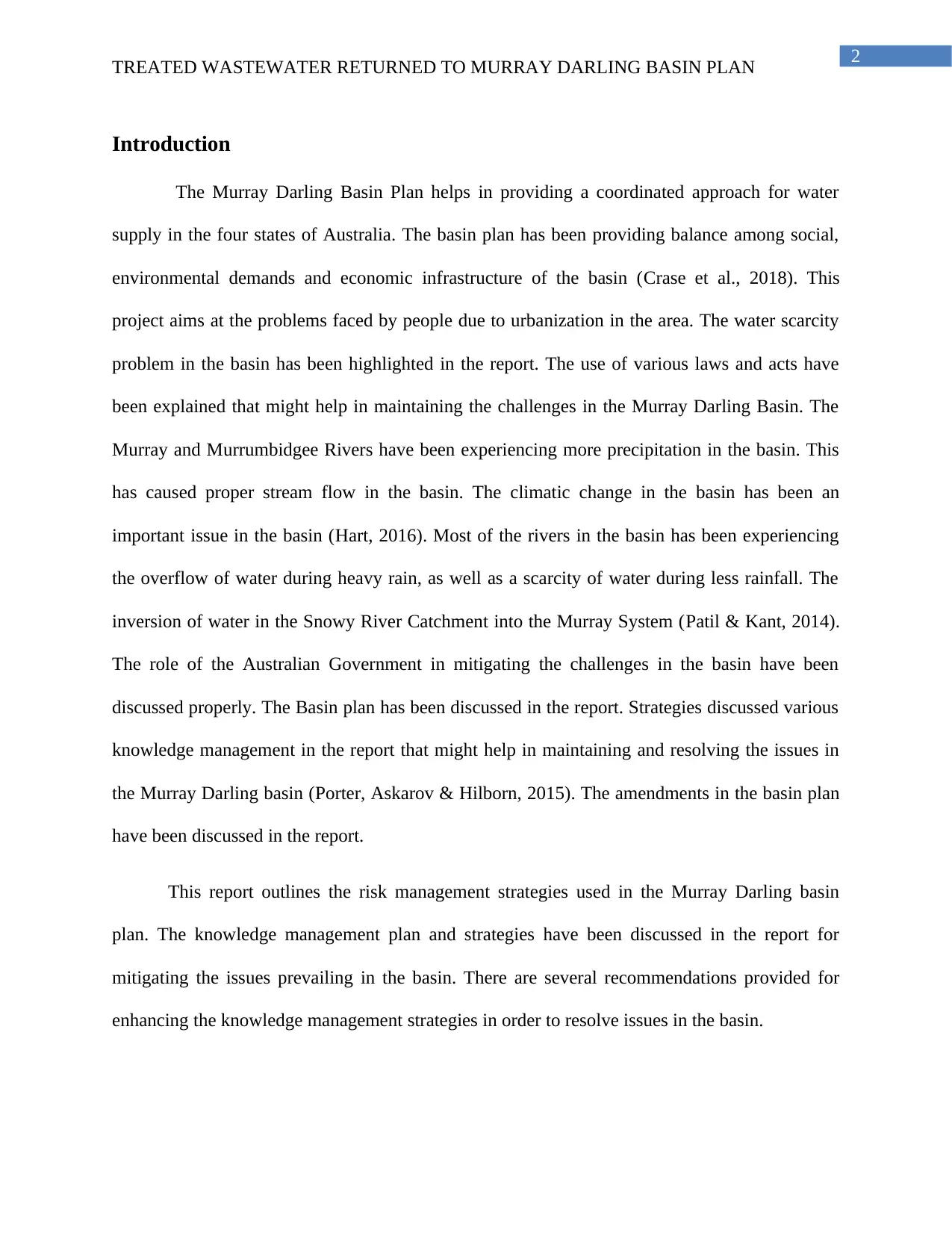
2
TREATED WASTEWATER RETURNED TO MURRAY DARLING BASIN PLAN
Introduction
The Murray Darling Basin Plan helps in providing a coordinated approach for water
supply in the four states of Australia. The basin plan has been providing balance among social,
environmental demands and economic infrastructure of the basin (Crase et al., 2018). This
project aims at the problems faced by people due to urbanization in the area. The water scarcity
problem in the basin has been highlighted in the report. The use of various laws and acts have
been explained that might help in maintaining the challenges in the Murray Darling Basin. The
Murray and Murrumbidgee Rivers have been experiencing more precipitation in the basin. This
has caused proper stream flow in the basin. The climatic change in the basin has been an
important issue in the basin (Hart, 2016). Most of the rivers in the basin has been experiencing
the overflow of water during heavy rain, as well as a scarcity of water during less rainfall. The
inversion of water in the Snowy River Catchment into the Murray System (Patil & Kant, 2014).
The role of the Australian Government in mitigating the challenges in the basin have been
discussed properly. The Basin plan has been discussed in the report. Strategies discussed various
knowledge management in the report that might help in maintaining and resolving the issues in
the Murray Darling basin (Porter, Askarov & Hilborn, 2015). The amendments in the basin plan
have been discussed in the report.
This report outlines the risk management strategies used in the Murray Darling basin
plan. The knowledge management plan and strategies have been discussed in the report for
mitigating the issues prevailing in the basin. There are several recommendations provided for
enhancing the knowledge management strategies in order to resolve issues in the basin.
TREATED WASTEWATER RETURNED TO MURRAY DARLING BASIN PLAN
Introduction
The Murray Darling Basin Plan helps in providing a coordinated approach for water
supply in the four states of Australia. The basin plan has been providing balance among social,
environmental demands and economic infrastructure of the basin (Crase et al., 2018). This
project aims at the problems faced by people due to urbanization in the area. The water scarcity
problem in the basin has been highlighted in the report. The use of various laws and acts have
been explained that might help in maintaining the challenges in the Murray Darling Basin. The
Murray and Murrumbidgee Rivers have been experiencing more precipitation in the basin. This
has caused proper stream flow in the basin. The climatic change in the basin has been an
important issue in the basin (Hart, 2016). Most of the rivers in the basin has been experiencing
the overflow of water during heavy rain, as well as a scarcity of water during less rainfall. The
inversion of water in the Snowy River Catchment into the Murray System (Patil & Kant, 2014).
The role of the Australian Government in mitigating the challenges in the basin have been
discussed properly. The Basin plan has been discussed in the report. Strategies discussed various
knowledge management in the report that might help in maintaining and resolving the issues in
the Murray Darling basin (Porter, Askarov & Hilborn, 2015). The amendments in the basin plan
have been discussed in the report.
This report outlines the risk management strategies used in the Murray Darling basin
plan. The knowledge management plan and strategies have been discussed in the report for
mitigating the issues prevailing in the basin. There are several recommendations provided for
enhancing the knowledge management strategies in order to resolve issues in the basin.
⊘ This is a preview!⊘
Do you want full access?
Subscribe today to unlock all pages.

Trusted by 1+ million students worldwide
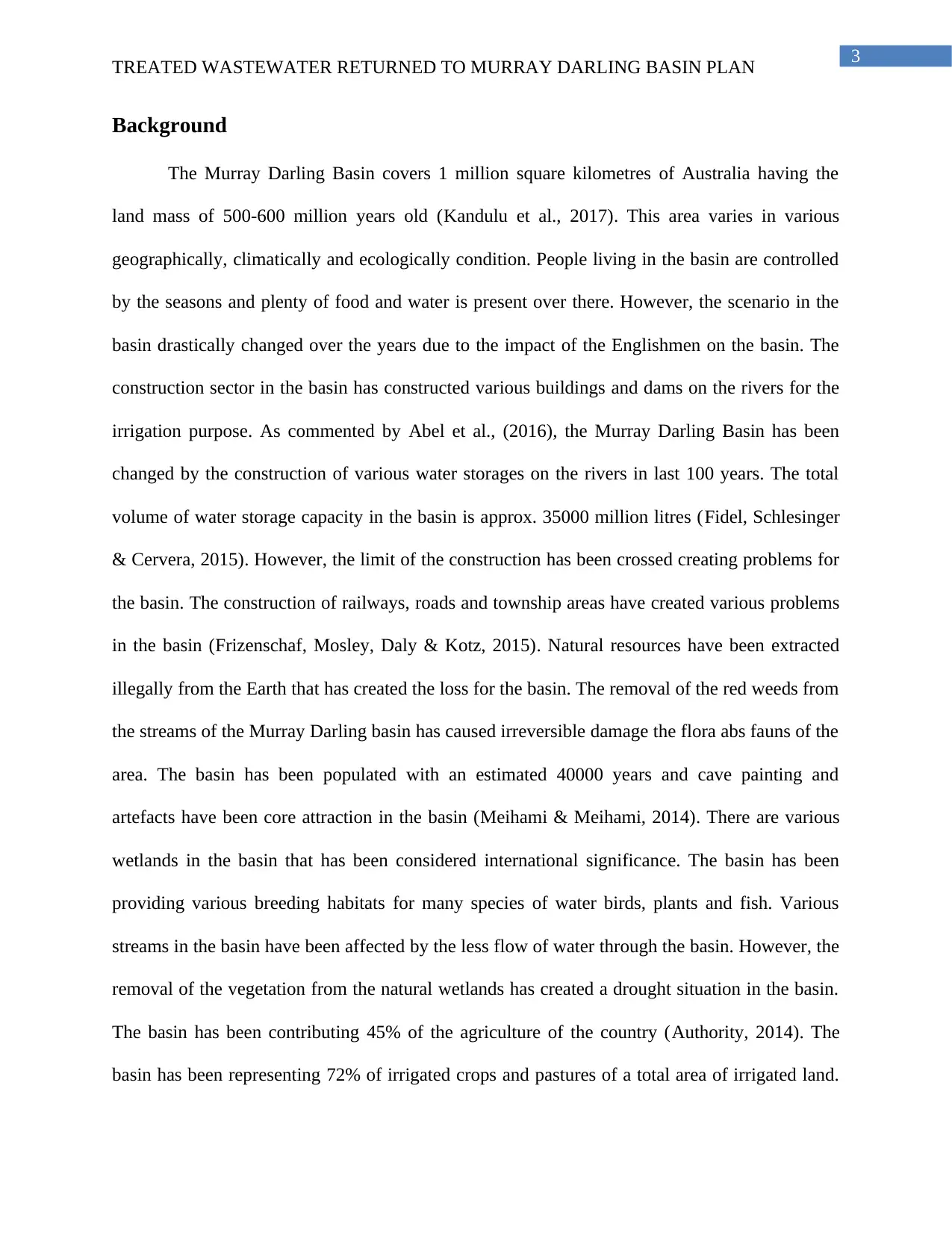
3
TREATED WASTEWATER RETURNED TO MURRAY DARLING BASIN PLAN
Background
The Murray Darling Basin covers 1 million square kilometres of Australia having the
land mass of 500-600 million years old (Kandulu et al., 2017). This area varies in various
geographically, climatically and ecologically condition. People living in the basin are controlled
by the seasons and plenty of food and water is present over there. However, the scenario in the
basin drastically changed over the years due to the impact of the Englishmen on the basin. The
construction sector in the basin has constructed various buildings and dams on the rivers for the
irrigation purpose. As commented by Abel et al., (2016), the Murray Darling Basin has been
changed by the construction of various water storages on the rivers in last 100 years. The total
volume of water storage capacity in the basin is approx. 35000 million litres (Fidel, Schlesinger
& Cervera, 2015). However, the limit of the construction has been crossed creating problems for
the basin. The construction of railways, roads and township areas have created various problems
in the basin (Frizenschaf, Mosley, Daly & Kotz, 2015). Natural resources have been extracted
illegally from the Earth that has created the loss for the basin. The removal of the red weeds from
the streams of the Murray Darling basin has caused irreversible damage the flora abs fauns of the
area. The basin has been populated with an estimated 40000 years and cave painting and
artefacts have been core attraction in the basin (Meihami & Meihami, 2014). There are various
wetlands in the basin that has been considered international significance. The basin has been
providing various breeding habitats for many species of water birds, plants and fish. Various
streams in the basin have been affected by the less flow of water through the basin. However, the
removal of the vegetation from the natural wetlands has created a drought situation in the basin.
The basin has been contributing 45% of the agriculture of the country (Authority, 2014). The
basin has been representing 72% of irrigated crops and pastures of a total area of irrigated land.
TREATED WASTEWATER RETURNED TO MURRAY DARLING BASIN PLAN
Background
The Murray Darling Basin covers 1 million square kilometres of Australia having the
land mass of 500-600 million years old (Kandulu et al., 2017). This area varies in various
geographically, climatically and ecologically condition. People living in the basin are controlled
by the seasons and plenty of food and water is present over there. However, the scenario in the
basin drastically changed over the years due to the impact of the Englishmen on the basin. The
construction sector in the basin has constructed various buildings and dams on the rivers for the
irrigation purpose. As commented by Abel et al., (2016), the Murray Darling Basin has been
changed by the construction of various water storages on the rivers in last 100 years. The total
volume of water storage capacity in the basin is approx. 35000 million litres (Fidel, Schlesinger
& Cervera, 2015). However, the limit of the construction has been crossed creating problems for
the basin. The construction of railways, roads and township areas have created various problems
in the basin (Frizenschaf, Mosley, Daly & Kotz, 2015). Natural resources have been extracted
illegally from the Earth that has created the loss for the basin. The removal of the red weeds from
the streams of the Murray Darling basin has caused irreversible damage the flora abs fauns of the
area. The basin has been populated with an estimated 40000 years and cave painting and
artefacts have been core attraction in the basin (Meihami & Meihami, 2014). There are various
wetlands in the basin that has been considered international significance. The basin has been
providing various breeding habitats for many species of water birds, plants and fish. Various
streams in the basin have been affected by the less flow of water through the basin. However, the
removal of the vegetation from the natural wetlands has created a drought situation in the basin.
The basin has been contributing 45% of the agriculture of the country (Authority, 2014). The
basin has been representing 72% of irrigated crops and pastures of a total area of irrigated land.
Paraphrase This Document
Need a fresh take? Get an instant paraphrase of this document with our AI Paraphraser
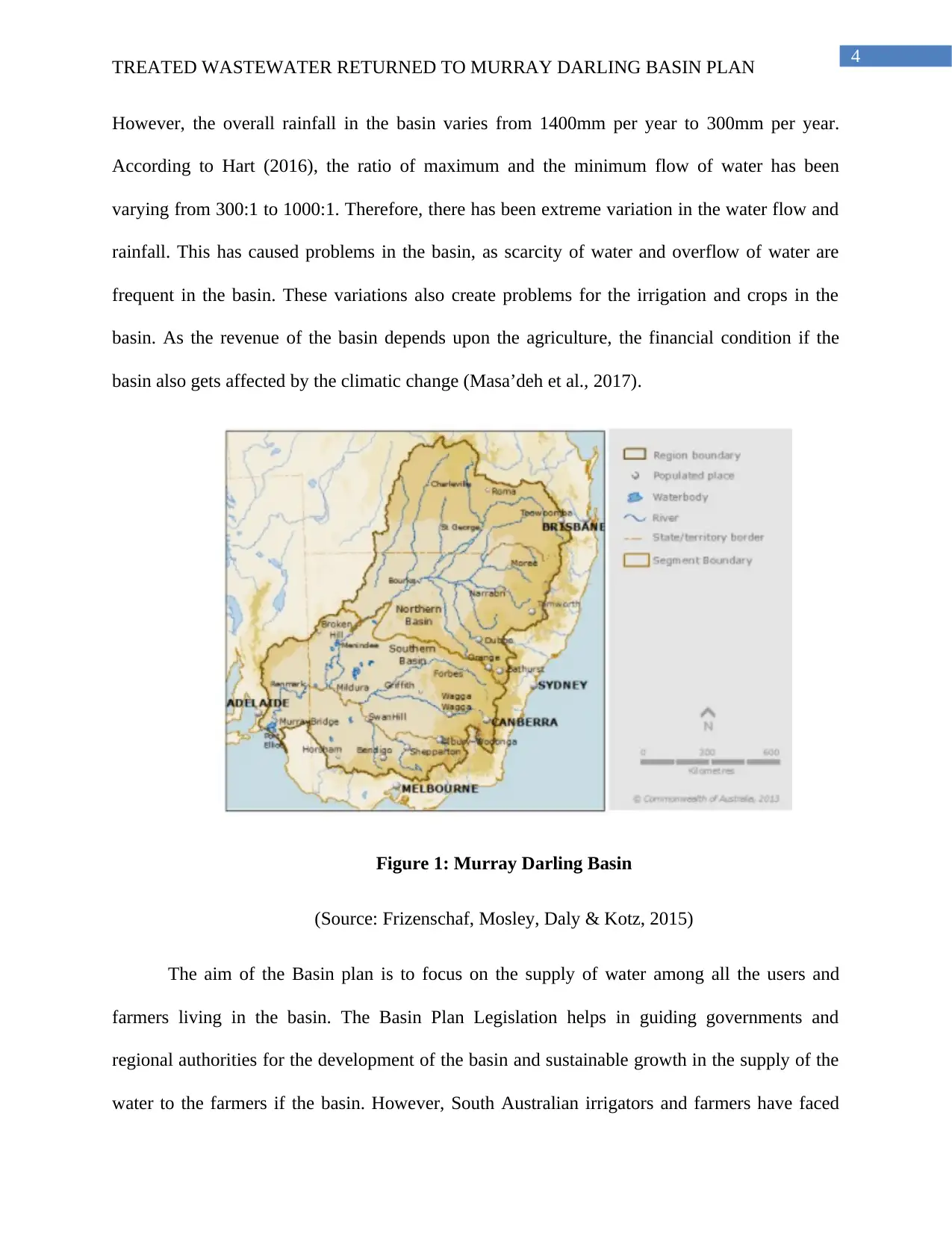
4
TREATED WASTEWATER RETURNED TO MURRAY DARLING BASIN PLAN
However, the overall rainfall in the basin varies from 1400mm per year to 300mm per year.
According to Hart (2016), the ratio of maximum and the minimum flow of water has been
varying from 300:1 to 1000:1. Therefore, there has been extreme variation in the water flow and
rainfall. This has caused problems in the basin, as scarcity of water and overflow of water are
frequent in the basin. These variations also create problems for the irrigation and crops in the
basin. As the revenue of the basin depends upon the agriculture, the financial condition if the
basin also gets affected by the climatic change (Masa’deh et al., 2017).
Figure 1: Murray Darling Basin
(Source: Frizenschaf, Mosley, Daly & Kotz, 2015)
The aim of the Basin plan is to focus on the supply of water among all the users and
farmers living in the basin. The Basin Plan Legislation helps in guiding governments and
regional authorities for the development of the basin and sustainable growth in the supply of the
water to the farmers if the basin. However, South Australian irrigators and farmers have faced
TREATED WASTEWATER RETURNED TO MURRAY DARLING BASIN PLAN
However, the overall rainfall in the basin varies from 1400mm per year to 300mm per year.
According to Hart (2016), the ratio of maximum and the minimum flow of water has been
varying from 300:1 to 1000:1. Therefore, there has been extreme variation in the water flow and
rainfall. This has caused problems in the basin, as scarcity of water and overflow of water are
frequent in the basin. These variations also create problems for the irrigation and crops in the
basin. As the revenue of the basin depends upon the agriculture, the financial condition if the
basin also gets affected by the climatic change (Masa’deh et al., 2017).
Figure 1: Murray Darling Basin
(Source: Frizenschaf, Mosley, Daly & Kotz, 2015)
The aim of the Basin plan is to focus on the supply of water among all the users and
farmers living in the basin. The Basin Plan Legislation helps in guiding governments and
regional authorities for the development of the basin and sustainable growth in the supply of the
water to the farmers if the basin. However, South Australian irrigators and farmers have faced
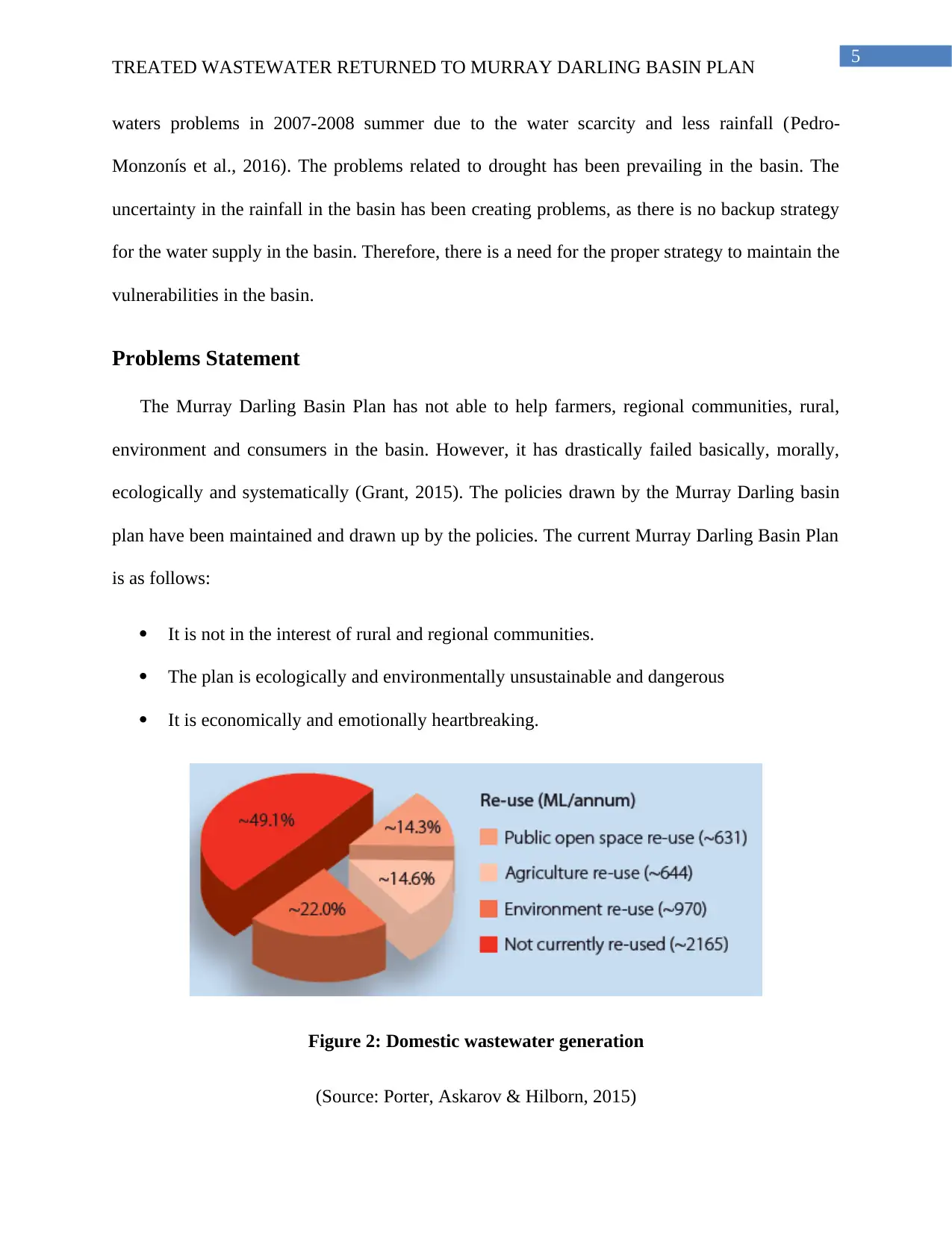
5
TREATED WASTEWATER RETURNED TO MURRAY DARLING BASIN PLAN
waters problems in 2007-2008 summer due to the water scarcity and less rainfall (Pedro-
Monzonís et al., 2016). The problems related to drought has been prevailing in the basin. The
uncertainty in the rainfall in the basin has been creating problems, as there is no backup strategy
for the water supply in the basin. Therefore, there is a need for the proper strategy to maintain the
vulnerabilities in the basin.
Problems Statement
The Murray Darling Basin Plan has not able to help farmers, regional communities, rural,
environment and consumers in the basin. However, it has drastically failed basically, morally,
ecologically and systematically (Grant, 2015). The policies drawn by the Murray Darling basin
plan have been maintained and drawn up by the policies. The current Murray Darling Basin Plan
is as follows:
It is not in the interest of rural and regional communities.
The plan is ecologically and environmentally unsustainable and dangerous
It is economically and emotionally heartbreaking.
Figure 2: Domestic wastewater generation
(Source: Porter, Askarov & Hilborn, 2015)
TREATED WASTEWATER RETURNED TO MURRAY DARLING BASIN PLAN
waters problems in 2007-2008 summer due to the water scarcity and less rainfall (Pedro-
Monzonís et al., 2016). The problems related to drought has been prevailing in the basin. The
uncertainty in the rainfall in the basin has been creating problems, as there is no backup strategy
for the water supply in the basin. Therefore, there is a need for the proper strategy to maintain the
vulnerabilities in the basin.
Problems Statement
The Murray Darling Basin Plan has not able to help farmers, regional communities, rural,
environment and consumers in the basin. However, it has drastically failed basically, morally,
ecologically and systematically (Grant, 2015). The policies drawn by the Murray Darling basin
plan have been maintained and drawn up by the policies. The current Murray Darling Basin Plan
is as follows:
It is not in the interest of rural and regional communities.
The plan is ecologically and environmentally unsustainable and dangerous
It is economically and emotionally heartbreaking.
Figure 2: Domestic wastewater generation
(Source: Porter, Askarov & Hilborn, 2015)
⊘ This is a preview!⊘
Do you want full access?
Subscribe today to unlock all pages.

Trusted by 1+ million students worldwide
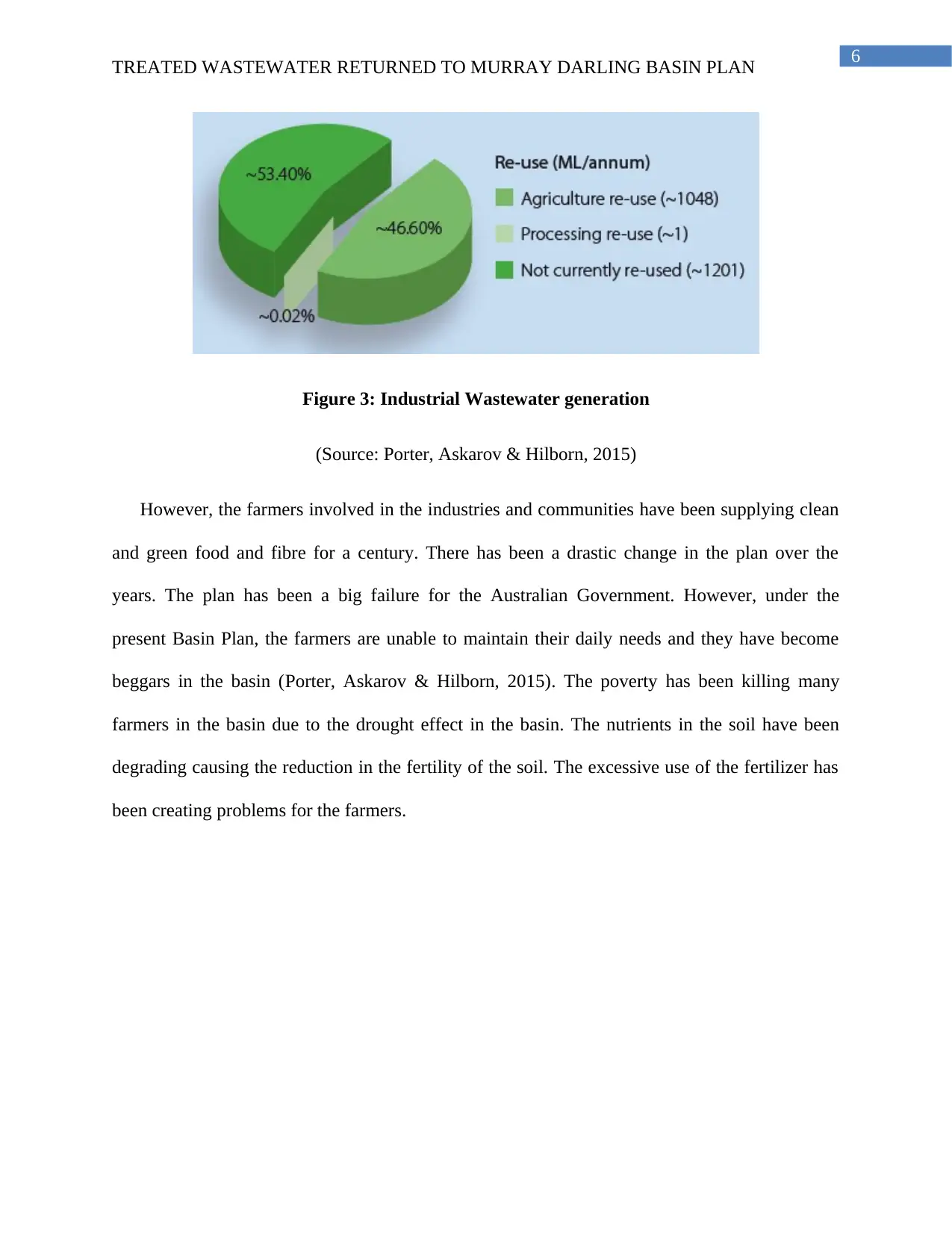
6
TREATED WASTEWATER RETURNED TO MURRAY DARLING BASIN PLAN
Figure 3: Industrial Wastewater generation
(Source: Porter, Askarov & Hilborn, 2015)
However, the farmers involved in the industries and communities have been supplying clean
and green food and fibre for a century. There has been a drastic change in the plan over the
years. The plan has been a big failure for the Australian Government. However, under the
present Basin Plan, the farmers are unable to maintain their daily needs and they have become
beggars in the basin (Porter, Askarov & Hilborn, 2015). The poverty has been killing many
farmers in the basin due to the drought effect in the basin. The nutrients in the soil have been
degrading causing the reduction in the fertility of the soil. The excessive use of the fertilizer has
been creating problems for the farmers.
TREATED WASTEWATER RETURNED TO MURRAY DARLING BASIN PLAN
Figure 3: Industrial Wastewater generation
(Source: Porter, Askarov & Hilborn, 2015)
However, the farmers involved in the industries and communities have been supplying clean
and green food and fibre for a century. There has been a drastic change in the plan over the
years. The plan has been a big failure for the Australian Government. However, under the
present Basin Plan, the farmers are unable to maintain their daily needs and they have become
beggars in the basin (Porter, Askarov & Hilborn, 2015). The poverty has been killing many
farmers in the basin due to the drought effect in the basin. The nutrients in the soil have been
degrading causing the reduction in the fertility of the soil. The excessive use of the fertilizer has
been creating problems for the farmers.
Paraphrase This Document
Need a fresh take? Get an instant paraphrase of this document with our AI Paraphraser
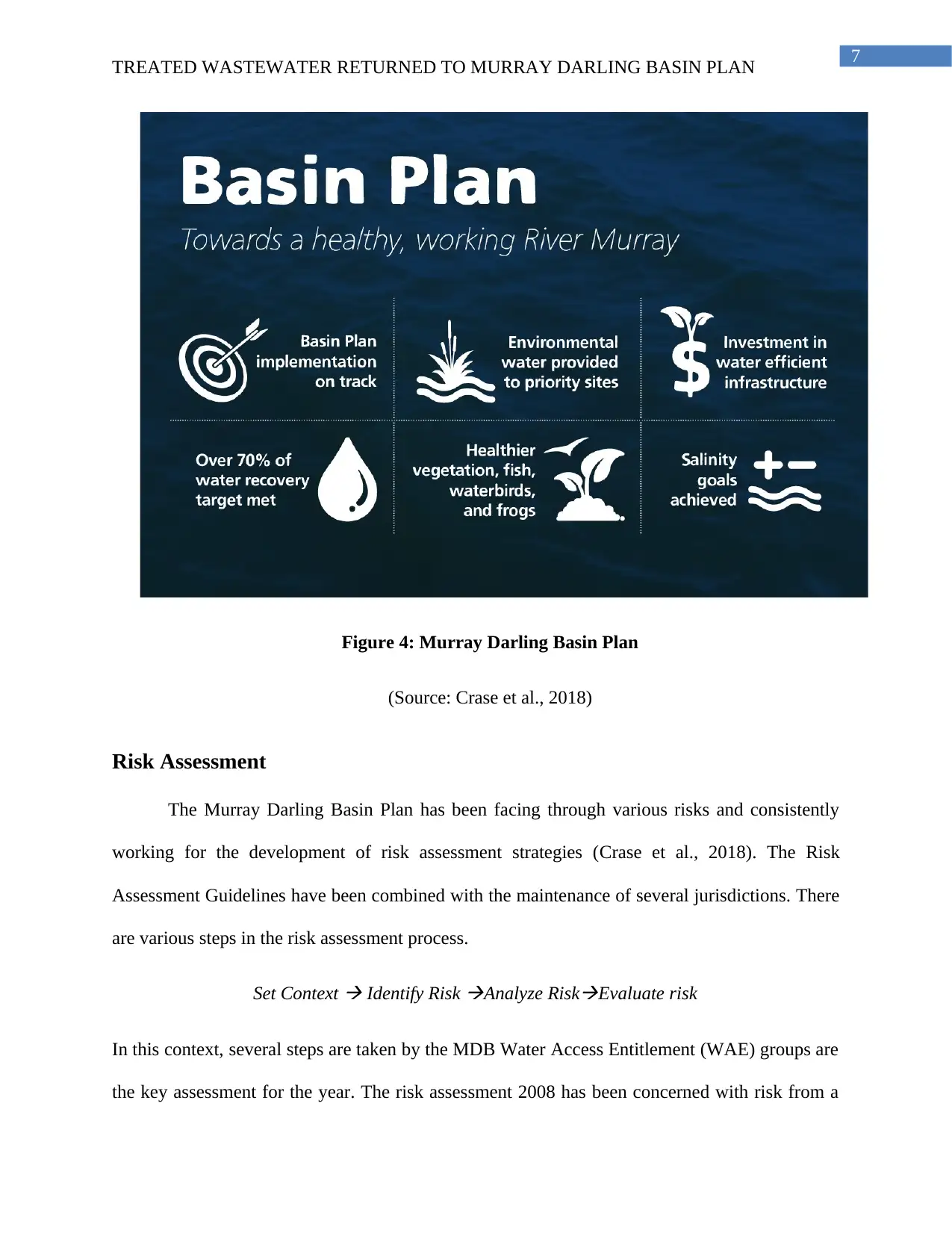
7
TREATED WASTEWATER RETURNED TO MURRAY DARLING BASIN PLAN
Figure 4: Murray Darling Basin Plan
(Source: Crase et al., 2018)
Risk Assessment
The Murray Darling Basin Plan has been facing through various risks and consistently
working for the development of risk assessment strategies (Crase et al., 2018). The Risk
Assessment Guidelines have been combined with the maintenance of several jurisdictions. There
are various steps in the risk assessment process.
Set Context
Identify Risk
Analyze Risk
Evaluate risk
In this context, several steps are taken by the MDB Water Access Entitlement (WAE) groups are
the key assessment for the year. The risk assessment 2008 has been concerned with risk from a
TREATED WASTEWATER RETURNED TO MURRAY DARLING BASIN PLAN
Figure 4: Murray Darling Basin Plan
(Source: Crase et al., 2018)
Risk Assessment
The Murray Darling Basin Plan has been facing through various risks and consistently
working for the development of risk assessment strategies (Crase et al., 2018). The Risk
Assessment Guidelines have been combined with the maintenance of several jurisdictions. There
are various steps in the risk assessment process.
Set Context
Identify Risk
Analyze Risk
Evaluate risk
In this context, several steps are taken by the MDB Water Access Entitlement (WAE) groups are
the key assessment for the year. The risk assessment 2008 has been concerned with risk from a
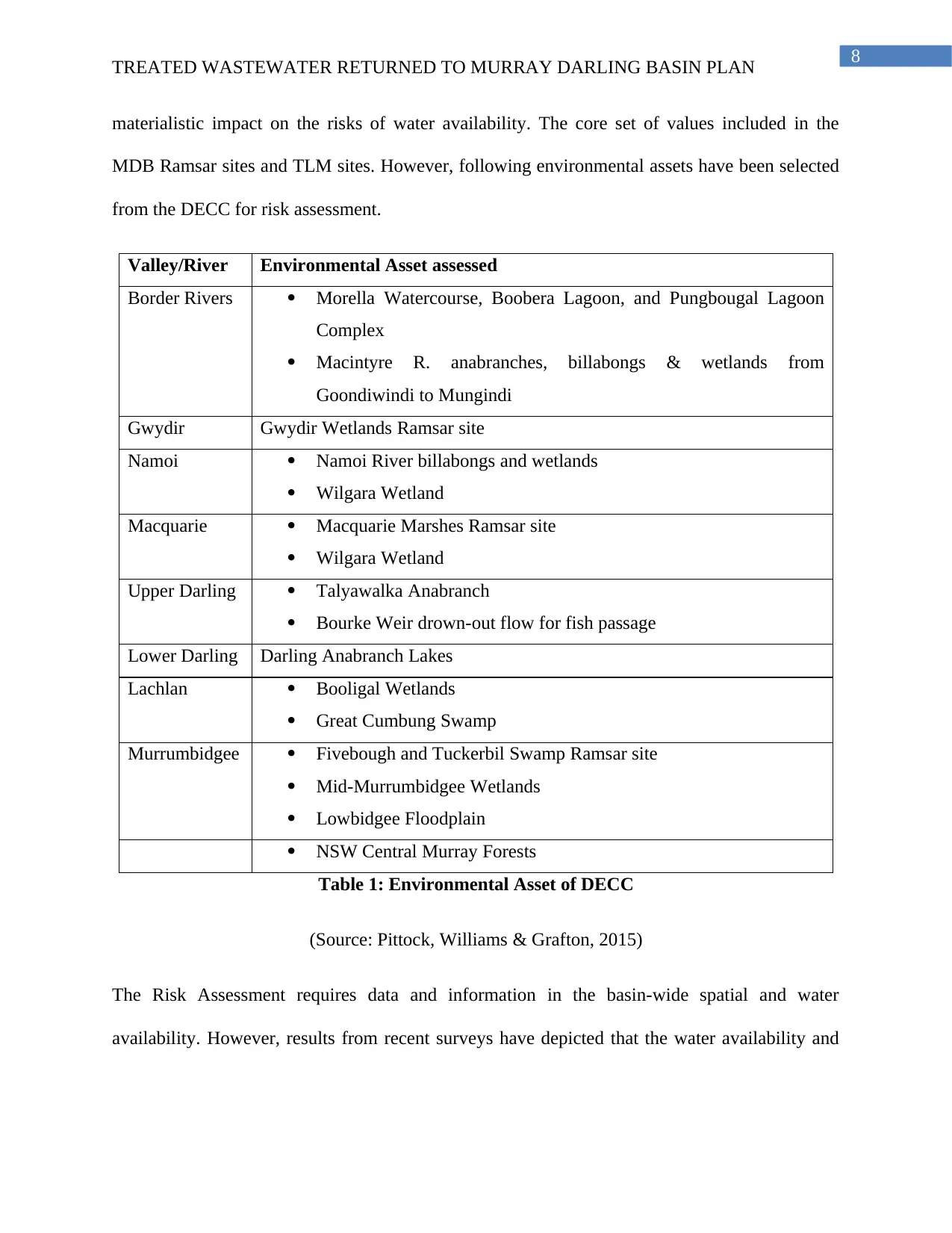
8
TREATED WASTEWATER RETURNED TO MURRAY DARLING BASIN PLAN
materialistic impact on the risks of water availability. The core set of values included in the
MDB Ramsar sites and TLM sites. However, following environmental assets have been selected
from the DECC for risk assessment.
Valley/River Environmental Asset assessed
Border Rivers Morella Watercourse, Boobera Lagoon, and Pungbougal Lagoon
Complex
Macintyre R. anabranches, billabongs & wetlands from
Goondiwindi to Mungindi
Gwydir Gwydir Wetlands Ramsar site
Namoi Namoi River billabongs and wetlands
Wilgara Wetland
Macquarie Macquarie Marshes Ramsar site
Wilgara Wetland
Upper Darling Talyawalka Anabranch
Bourke Weir drown-out flow for fish passage
Lower Darling Darling Anabranch Lakes
Lachlan Booligal Wetlands
Great Cumbung Swamp
Murrumbidgee Fivebough and Tuckerbil Swamp Ramsar site
Mid-Murrumbidgee Wetlands
Lowbidgee Floodplain
NSW Central Murray Forests
Table 1: Environmental Asset of DECC
(Source: Pittock, Williams & Grafton, 2015)
The Risk Assessment requires data and information in the basin-wide spatial and water
availability. However, results from recent surveys have depicted that the water availability and
TREATED WASTEWATER RETURNED TO MURRAY DARLING BASIN PLAN
materialistic impact on the risks of water availability. The core set of values included in the
MDB Ramsar sites and TLM sites. However, following environmental assets have been selected
from the DECC for risk assessment.
Valley/River Environmental Asset assessed
Border Rivers Morella Watercourse, Boobera Lagoon, and Pungbougal Lagoon
Complex
Macintyre R. anabranches, billabongs & wetlands from
Goondiwindi to Mungindi
Gwydir Gwydir Wetlands Ramsar site
Namoi Namoi River billabongs and wetlands
Wilgara Wetland
Macquarie Macquarie Marshes Ramsar site
Wilgara Wetland
Upper Darling Talyawalka Anabranch
Bourke Weir drown-out flow for fish passage
Lower Darling Darling Anabranch Lakes
Lachlan Booligal Wetlands
Great Cumbung Swamp
Murrumbidgee Fivebough and Tuckerbil Swamp Ramsar site
Mid-Murrumbidgee Wetlands
Lowbidgee Floodplain
NSW Central Murray Forests
Table 1: Environmental Asset of DECC
(Source: Pittock, Williams & Grafton, 2015)
The Risk Assessment requires data and information in the basin-wide spatial and water
availability. However, results from recent surveys have depicted that the water availability and
⊘ This is a preview!⊘
Do you want full access?
Subscribe today to unlock all pages.

Trusted by 1+ million students worldwide
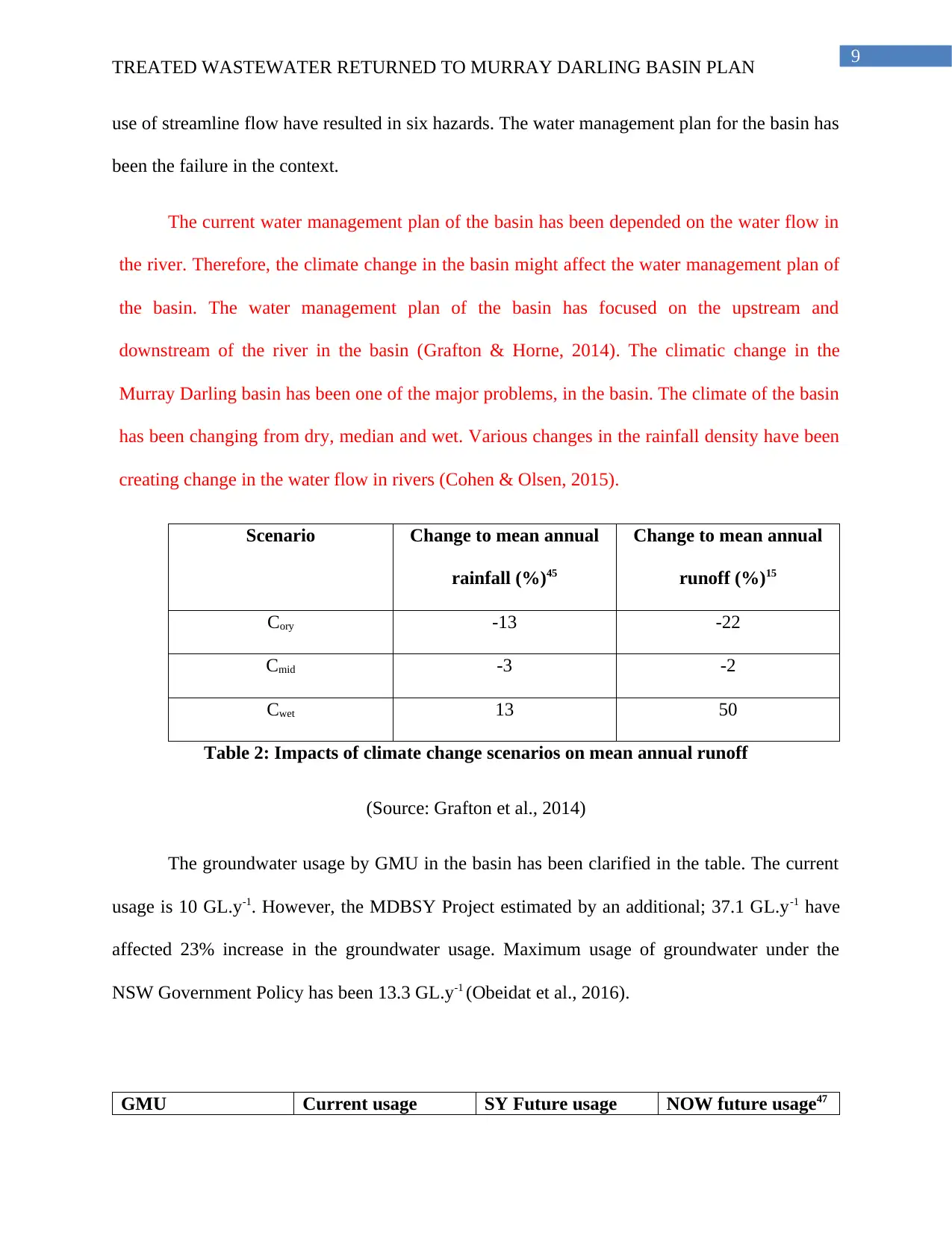
9
TREATED WASTEWATER RETURNED TO MURRAY DARLING BASIN PLAN
use of streamline flow have resulted in six hazards. The water management plan for the basin has
been the failure in the context.
The current water management plan of the basin has been depended on the water flow in
the river. Therefore, the climate change in the basin might affect the water management plan of
the basin. The water management plan of the basin has focused on the upstream and
downstream of the river in the basin (Grafton & Horne, 2014). The climatic change in the
Murray Darling basin has been one of the major problems, in the basin. The climate of the basin
has been changing from dry, median and wet. Various changes in the rainfall density have been
creating change in the water flow in rivers (Cohen & Olsen, 2015).
Scenario Change to mean annual
rainfall (%)45
Change to mean annual
runoff (%)15
Cory -13 -22
Cmid -3 -2
Cwet 13 50
Table 2: Impacts of climate change scenarios on mean annual runoff
(Source: Grafton et al., 2014)
The groundwater usage by GMU in the basin has been clarified in the table. The current
usage is 10 GL.y-1. However, the MDBSY Project estimated by an additional; 37.1 GL.y-1 have
affected 23% increase in the groundwater usage. Maximum usage of groundwater under the
NSW Government Policy has been 13.3 GL.y-1 (Obeidat et al., 2016).
GMU Current usage SY Future usage NOW future usage47
TREATED WASTEWATER RETURNED TO MURRAY DARLING BASIN PLAN
use of streamline flow have resulted in six hazards. The water management plan for the basin has
been the failure in the context.
The current water management plan of the basin has been depended on the water flow in
the river. Therefore, the climate change in the basin might affect the water management plan of
the basin. The water management plan of the basin has focused on the upstream and
downstream of the river in the basin (Grafton & Horne, 2014). The climatic change in the
Murray Darling basin has been one of the major problems, in the basin. The climate of the basin
has been changing from dry, median and wet. Various changes in the rainfall density have been
creating change in the water flow in rivers (Cohen & Olsen, 2015).
Scenario Change to mean annual
rainfall (%)45
Change to mean annual
runoff (%)15
Cory -13 -22
Cmid -3 -2
Cwet 13 50
Table 2: Impacts of climate change scenarios on mean annual runoff
(Source: Grafton et al., 2014)
The groundwater usage by GMU in the basin has been clarified in the table. The current
usage is 10 GL.y-1. However, the MDBSY Project estimated by an additional; 37.1 GL.y-1 have
affected 23% increase in the groundwater usage. Maximum usage of groundwater under the
NSW Government Policy has been 13.3 GL.y-1 (Obeidat et al., 2016).
GMU Current usage SY Future usage NOW future usage47
Paraphrase This Document
Need a fresh take? Get an instant paraphrase of this document with our AI Paraphraser
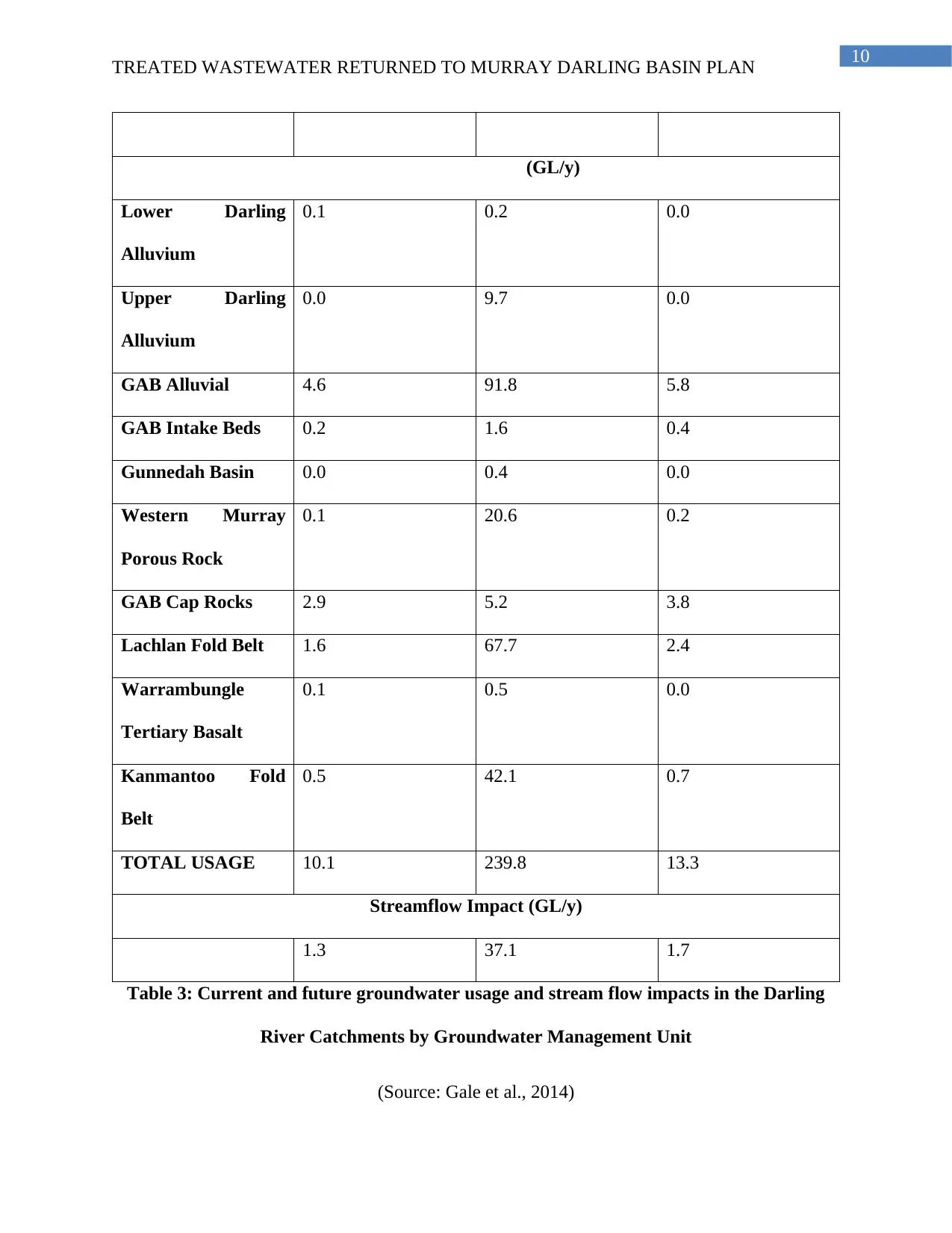
10
TREATED WASTEWATER RETURNED TO MURRAY DARLING BASIN PLAN
(GL/y)
Lower Darling
Alluvium
0.1 0.2 0.0
Upper Darling
Alluvium
0.0 9.7 0.0
GAB Alluvial 4.6 91.8 5.8
GAB Intake Beds 0.2 1.6 0.4
Gunnedah Basin 0.0 0.4 0.0
Western Murray
Porous Rock
0.1 20.6 0.2
GAB Cap Rocks 2.9 5.2 3.8
Lachlan Fold Belt 1.6 67.7 2.4
Warrambungle
Tertiary Basalt
0.1 0.5 0.0
Kanmantoo Fold
Belt
0.5 42.1 0.7
TOTAL USAGE 10.1 239.8 13.3
Streamflow Impact (GL/y)
1.3 37.1 1.7
Table 3: Current and future groundwater usage and stream flow impacts in the Darling
River Catchments by Groundwater Management Unit
(Source: Gale et al., 2014)
TREATED WASTEWATER RETURNED TO MURRAY DARLING BASIN PLAN
(GL/y)
Lower Darling
Alluvium
0.1 0.2 0.0
Upper Darling
Alluvium
0.0 9.7 0.0
GAB Alluvial 4.6 91.8 5.8
GAB Intake Beds 0.2 1.6 0.4
Gunnedah Basin 0.0 0.4 0.0
Western Murray
Porous Rock
0.1 20.6 0.2
GAB Cap Rocks 2.9 5.2 3.8
Lachlan Fold Belt 1.6 67.7 2.4
Warrambungle
Tertiary Basalt
0.1 0.5 0.0
Kanmantoo Fold
Belt
0.5 42.1 0.7
TOTAL USAGE 10.1 239.8 13.3
Streamflow Impact (GL/y)
1.3 37.1 1.7
Table 3: Current and future groundwater usage and stream flow impacts in the Darling
River Catchments by Groundwater Management Unit
(Source: Gale et al., 2014)
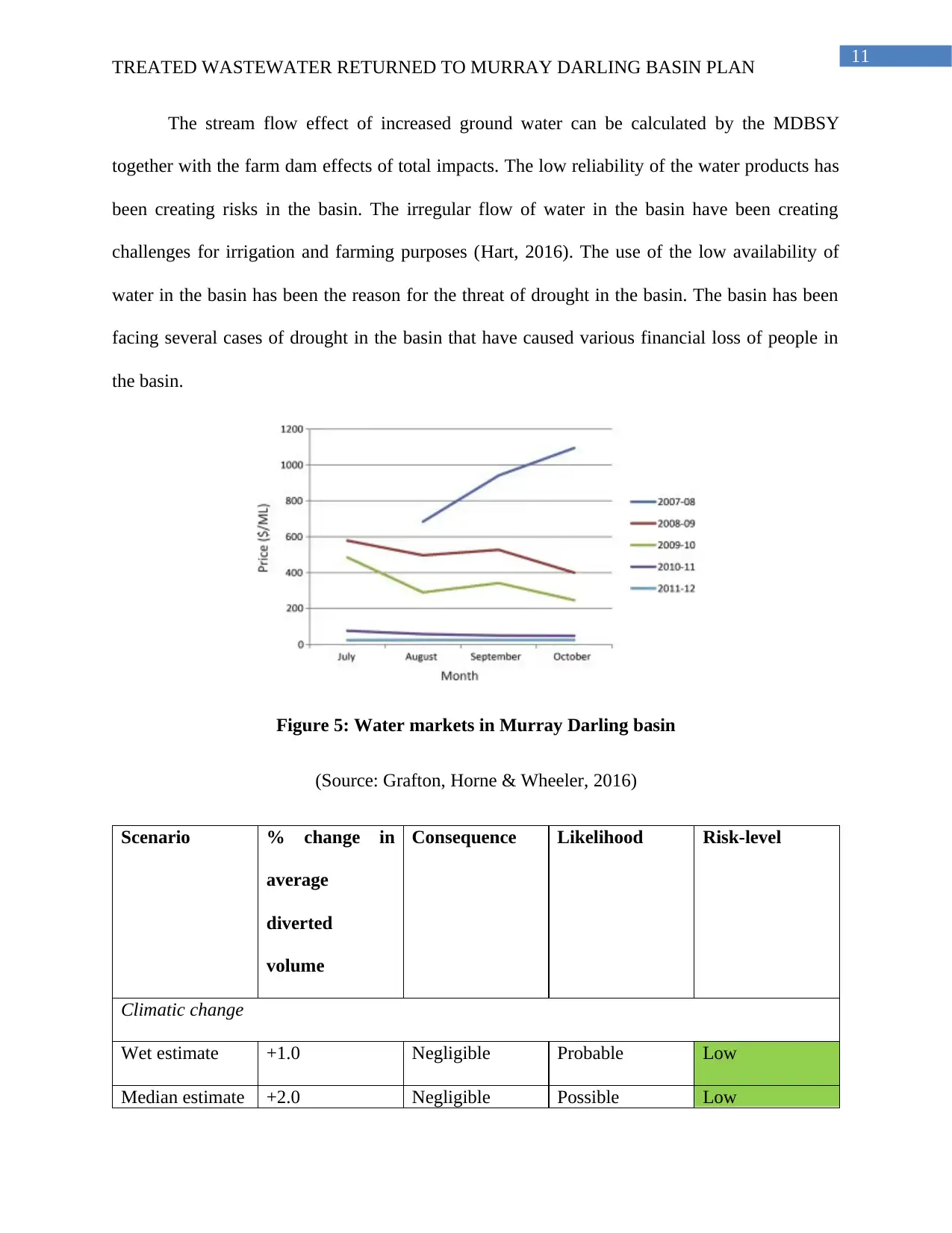
11
TREATED WASTEWATER RETURNED TO MURRAY DARLING BASIN PLAN
The stream flow effect of increased ground water can be calculated by the MDBSY
together with the farm dam effects of total impacts. The low reliability of the water products has
been creating risks in the basin. The irregular flow of water in the basin have been creating
challenges for irrigation and farming purposes (Hart, 2016). The use of the low availability of
water in the basin has been the reason for the threat of drought in the basin. The basin has been
facing several cases of drought in the basin that have caused various financial loss of people in
the basin.
Figure 5: Water markets in Murray Darling basin
(Source: Grafton, Horne & Wheeler, 2016)
Scenario % change in
average
diverted
volume
Consequence Likelihood Risk-level
Climatic change
Wet estimate +1.0 Negligible Probable Low
Median estimate +2.0 Negligible Possible Low
TREATED WASTEWATER RETURNED TO MURRAY DARLING BASIN PLAN
The stream flow effect of increased ground water can be calculated by the MDBSY
together with the farm dam effects of total impacts. The low reliability of the water products has
been creating risks in the basin. The irregular flow of water in the basin have been creating
challenges for irrigation and farming purposes (Hart, 2016). The use of the low availability of
water in the basin has been the reason for the threat of drought in the basin. The basin has been
facing several cases of drought in the basin that have caused various financial loss of people in
the basin.
Figure 5: Water markets in Murray Darling basin
(Source: Grafton, Horne & Wheeler, 2016)
Scenario % change in
average
diverted
volume
Consequence Likelihood Risk-level
Climatic change
Wet estimate +1.0 Negligible Probable Low
Median estimate +2.0 Negligible Possible Low
⊘ This is a preview!⊘
Do you want full access?
Subscribe today to unlock all pages.

Trusted by 1+ million students worldwide
1 out of 36
Related Documents
Your All-in-One AI-Powered Toolkit for Academic Success.
+13062052269
info@desklib.com
Available 24*7 on WhatsApp / Email
![[object Object]](/_next/static/media/star-bottom.7253800d.svg)
Unlock your academic potential
Copyright © 2020–2025 A2Z Services. All Rights Reserved. Developed and managed by ZUCOL.



